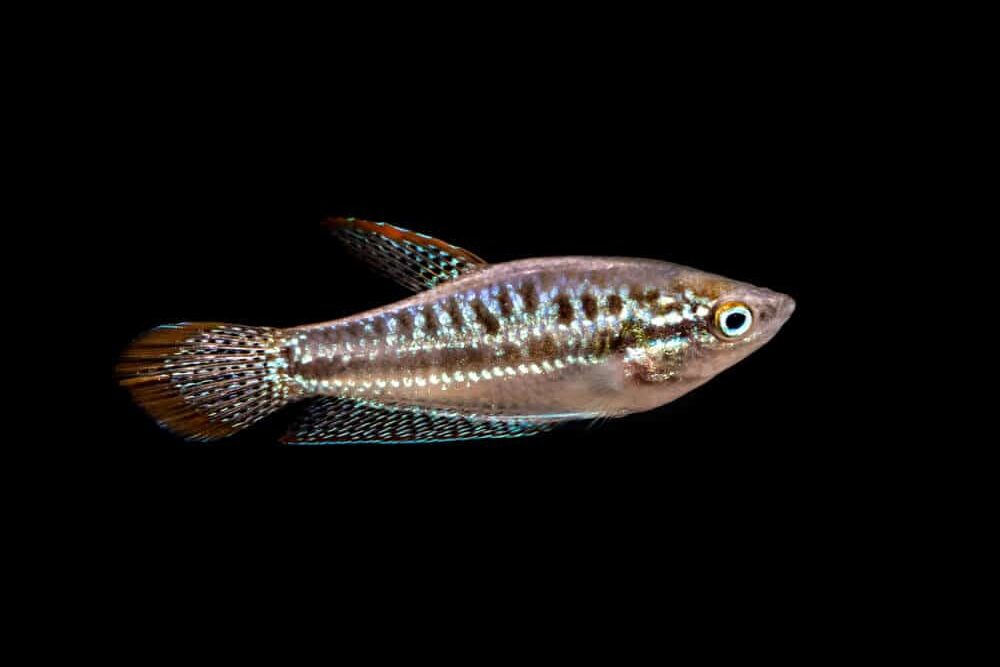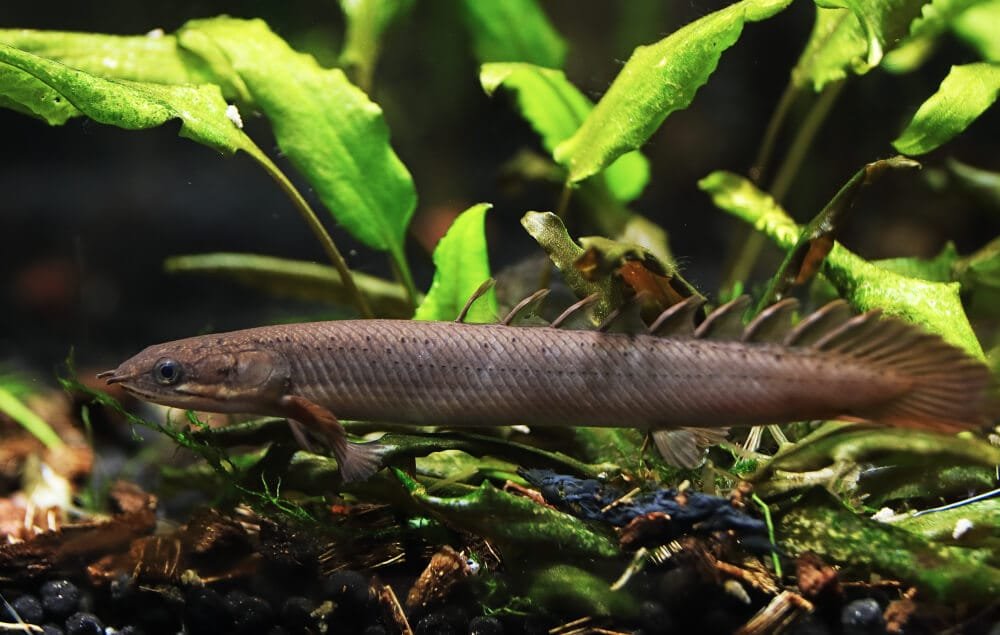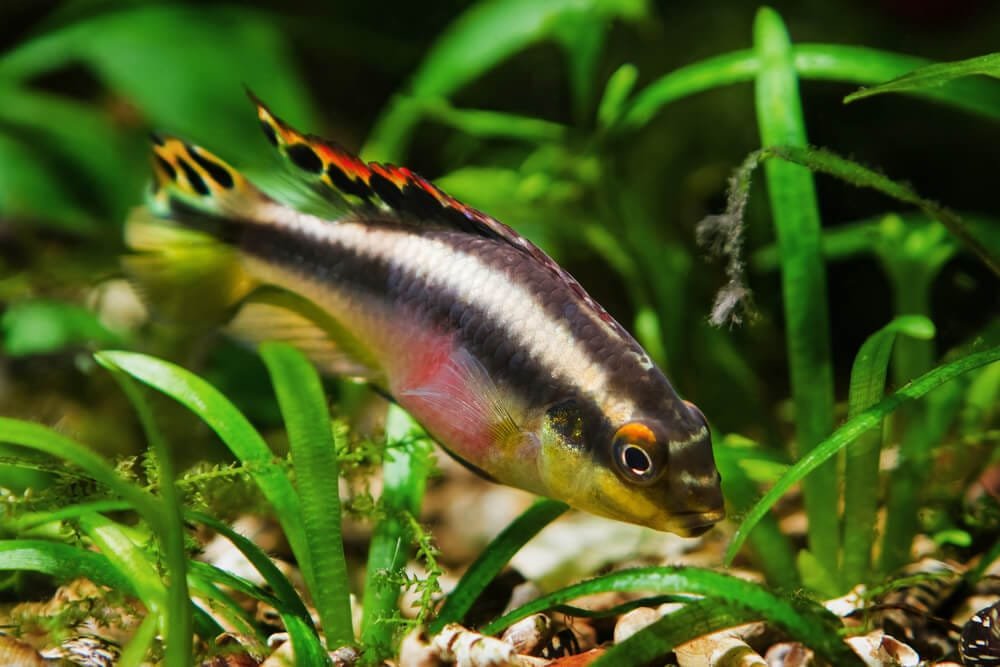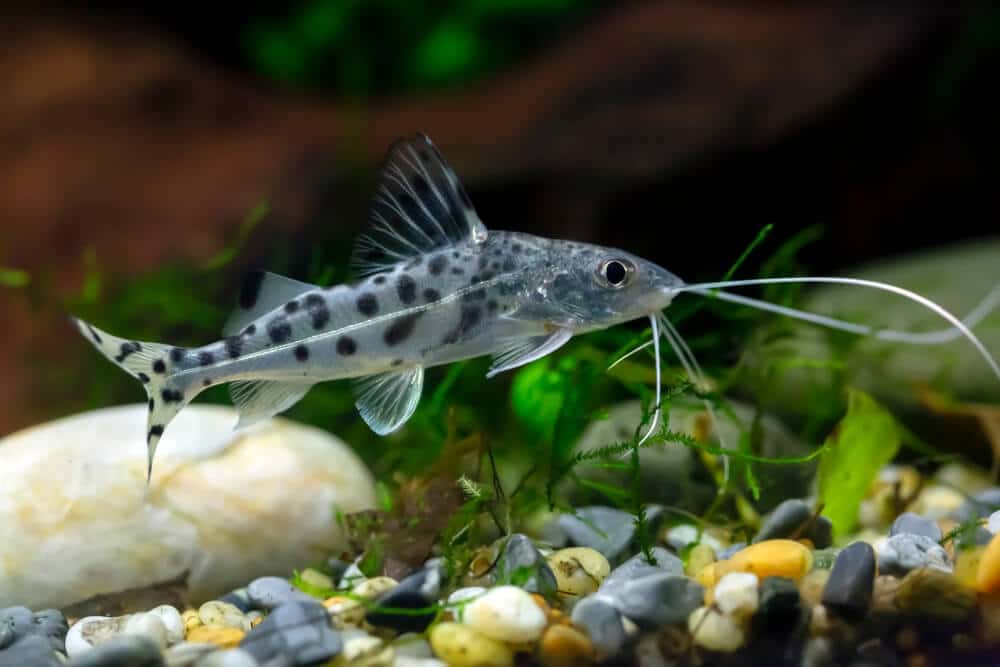Native to southeast Asia, these freshwater fish can adapt to extreme environments. They thrive well in slow-moving water with lots of vegetation. You will often find them swimming to the surface of the water to breathe in oxygen. This is because they have a labyrinth organ, which functions as a lung.
In most cases, a species aquarium is recommended for the Sparkling Gourami. Nevertheless, this fish species can be kept with other fish species if you want to grow your fish community.
Since the Sparkling Gourami is a peaceful and non-aggressive small fish, it helps to choose a tank mate that is equally peaceful and small in size. Otherwise, placing it with an aggressive or larger fish will cause it to be stressed and it may not last very long.
Some excellent Sparkling Gourami tank mates include Dwarf Gourami, Cory Catfish, Ember Tetras, Neon Tetras, Yoyo Loach, Harlequin Rasboras, Darf PencilFish, and Otocinclus.
9 Best Sparkling Gourami Tank Mates
In this article, we will look at these fish species to understand why they are the most suitable tank mates for the Sparkling Gourami.
1. Dwarf Gourami
Size: 2-5 inches
Minimum Tank Size: 10 gallons
Temperature: 72-82 Degrees F
Diet: Omnivorous
Temperament: Peaceful
Care Level: Beginner

If you are looking for a Sparkling Gourami tank mate that will add color to your tank, the Dwarf Gourami would be a great choice. This freshwater fish is beautiful and is known for its peaceful attitude when placed together with other fish species.
Plus, it belongs to the Gourami family and hails from India, Pakistan, and Bangladesh. This fish species is a top or middle dweller since it needs to reach the surface with ease to get oxygen.
Just like the Sparkling Gourami, they don’t like causing trouble and would rather stay away from anything that stresses them. Hence, these two fish species make great chemistry when placed together in a tank.
Generally, there are different types of Dwarf Gourami that you can choose from including the Flame Dwarf Gourami, the Honey Dwarf, Neon Blue Dwarf Gourami, and the Powder Blue Dwarf Gourami, which is the most popular.
Caring for these fish is very easy due to their simple diet. They are not very picky but need to ensure that you feed them the correct food that will not only keep them healthy but also help to maintain their beautiful color.
These can be things like live foods and vegetable-based flakes. Also, ensure that you change their water regularly to keep them healthy and less prone to the Dwarf Gourami Disease (DGD). Finally, be mindful of the room temperature because a significant difference could harm their labyrinth organ, which helps them take in oxygen.
2. Cory Catfish
Size: 2-5 inches
Minimum Tank Size: 10 gallons
Temperature: 70-80 Degrees F
Diet: Omnivorous
Temperament: Peaceful
Care Level: Beginner to Intermediate

Small bottom dwellers like the Cory Catfish can also make an excellent tank mate for the Sparkling Gourami. This is because they won’t have to compete for the surface, which is where Sparkling Gouramis get their oxygen.
Also known as Cory Cats, these fish originate from South America and can live for more than 20 years when kept in the right tank conditions. Generally, they are easy to care for despite being hardy fish.
They can school in groups of up to 5 to 6 species without attacking them. Smaller Corys can thrive well in a 10-gallon tank, though you may need a 30-gallon tank if you intend to place them in groups of 5 or 6.
These bottom dwellers are a great addition to a freshwater tank and anyone and care for them regardless of their experience level. Corys are also peaceful and make wonderful tankmates for other species, including bottom dwellers.
The best part is that it comes in different popular types, making it easy to choose one for your aquarium. Some of the Cory Catfish types out there include Green Cory Catfish, Panda Cory Catfish, Albino Cory Catfish, Pygmy Cory Catfish, and more.
You should also know that they are dubbed live-in janitors to their ability to scavenge algae in the tank. However, these fish cannot survive on algae alone. Thus, you will need to feed them other foods like live foods, brine shrimp, fish flakes, bloodworms, insect larvae, and more.
3. Neon Tetras
Size: 1-1.5 inches
Minimum Tank Size: 10 gallons
Temperature: 70-81 Degrees F
Diet: Omnivorous
Temperament: Peaceful
Care Level: Easy

Neon Tetras are beautiful, peaceful, and pretty active freshwater fish that have gained popularity in the aquarist community. This is probably because of their easy-to-care nature and their striking color pattern of red, blue, and white that can add life to any aquarium.
If you opt for this species, then you should be ready to maintain a freshwater aquarium that is heavily planted. They love to get away in dark places and dense vegetation and floating plants make this possible. Nevertheless, don’t forget to leave enough space for them at school and find a bit of lighting.
Tetras love to school and feed together and should be kept in groups of at least 15. Schooling helps to keep them active and healthy; otherwise, they may be prone to stress.
Caring for them is extremely easy since they are hardy and don’t need a lot of attention. Generally, you need to ensure that you give them a proper diet and maintain quality water conditions. If these conditions are met, they can live between 5 and 10 years.
As for the diet, these fish are omnivorous and can feed on almost anything, including live and frozen foods. They can feed on organic matter while in the wild. It is highly recommended to feed them small pieces of food because of their small mouth.
4. Pearl Gourami
Size: 4-5 inches
Minimum Tank Size: 30 gallons
Temperature: 77-82 Degrees F
Diet: Omnivorous
Temperament: Mellow
Care Level: Easy

This is another Sparkling Gourami tank mate from the Gourami family worth considering. This fish is happier when shoaling with other non-aggressive fish.
Pearl Gourami is fun and has a thin, flat body with white, pearl-like sheens; hence the name. You probably know it as Mosaic Gourami or Lace Gourami as well.
The pearl-like dots make it easy to spot among other Gourami fish species. It also has a noticeable black line that runs in the middle.
This freshwater fish originates from East Asia in countries like Indonesia, Thailand, and Malaysia. It grows between 4 to 5 inches and can live up to 5 years in the native habitat and up to 7 years or more when placed in an aquarium with optimal conditions.
Like the Sparkling Gourami, the Pearl Gourami has a peaceful and timid temperate. Because of this nature, they tend to hide in plants and other dark places. Nevertheless, it is worth knowing that the males can be a bit aggressive, particularly in the mating season.
Caring for your Pearl Gourami is quite easy and you just need to know the basics like diet, water conditions, and the tank size and setup. Compared to other fish species on our list, this fish is a bit large and requires a tank size with a minimum of 30 gallons.
Therefore, if you intend to add it to your Sparkling Gourami, you need a much larger tank size. Also, don’t forget to decorate their tank with vegetation and rocks to replicate their natural habitat.
However, floating plants are not recommended because they can hinder these labyrinth fish from accessing the top surface from getting air with ease. Being omnivorous, this fish has plenty of food options like brine shrimp, black worms, bloodworms, and glass worms.
5. Ember Tetras
Size: 0.6-0.8 inches
Minimum Tank Size: 10 gallons
Temperature: 73-84 Degrees F
Diet: Omnivorous
Temperament: Non-aggressive, playful
Care Level: Easy

If your Sparkling Gourami aquarium contains heavy vegetation, the Ember Tetra can make an excellent companion. The optimal condition for this fish species to thrive is a heavily forested aquarium. When placed in a tank with scarce or no vegetation, their color may fade and this can also affect their health.
They originate from Central-Western Brazil where their natural habitat is slow-moving water with thick vegetation. Although their life expectancy period is 2-4 years, they can live beyond this when placed in optimal tank conditions.
From the first look, these fish are small in size and measure an average of fewer than 1 inch. They can, therefore, fit well in 10-gallon tanks or nano tanks. Just ensure that you have adequate space to grow plants and don’t overcrowd the fish.
What stands out most is their vibrant colors or fiery red or orange. Their aesthetic appeal can capture the attention of anyone, especially when they swim.
Like most aquarists, you will probably enjoy watching them swim and play in the vegetation. They are fast swimmers and can be very active once they adapt to their new environment.
They are shoaling and love to be kept in groups. Nevertheless, they can be a bit shy and you may notice that they hide most of the time.
Feeding them is pretty easy but you need to ensure that the food is quality and well-balanced to improve their immunity. A balanced diet also helps retain their beautiful color. Besides, it is highly suggested that you break down their food because of their small size.
6. Harlequin Rasboras
Size: 2 inches
Minimum Tank Size: 10 gallons
Temperature: 70-82 Degrees F
Diet: Omnivorous
Temperament: Peaceful, Playful
Care Level: Easy

With a playful nature, metallic color, and easy-to-maintain nature, it is not surprising that Harlequin Rasboras are among the most popular fish for aquarists worldwide. They are great for beginners because they are hardy and need very minimal care and attention.
You just need to ensure that you feed them the right diet, maintain the right tank conditions, and remain the left-over food. Also, you must maintain slightly acidic water.
Most importantly, these fish are very peaceful and you will hardly find them acting aggressively toward others. They not only do well with other rasboras species but also with other fish species as long as they are peaceful and non-aggressive.
As for the diet, you can give them veggies and meat whether it is live food, frozen, dried, or flake. If possible, crush the food so it can fit in their small mouths.
These non-picky eaters can also eat algae in the food. They measure a maximum size of two inches, meaning that they can fit well in a tank size of about 10 gallons. These fish love to stay in groups of 4 to 6 fishes, so you should consider this when adding them to your aquarium.
Since they are middle dwellers, you can decorate the tank with different types of substrate. But most importantly, ensure that you place rocks and Cryptocoryne plants to resemble their natural habitat in Asian rivers.
7. Yoyo Loach
Size: 2-3 inches
Minimum Tank Size: 40 gallons
Temperature: 74-85 Degrees F
Diet: Omnivorous
Temperament: Social, Energetic
Care Level: Experience needed

Named after their pattern that looks like Yoyo, these fish species are known for their playful nature. They are very energetic and you will notice that they love to put on a show but they are not competitive. This makes them a great addition to your tank.
They are often found in the bottom and middle parts of the aquarium and you will see them very active, especially during the day. You can see them explore their surroundings in your tank.
Despite being bottom dwellers, Yolo Loaches are very social and will interact with other fish in the tank. They are shoaling and should be kept in groups of between 5 and 6. However, if you are keeping Yolo Loaches, you want to ensure that females are more than males.
Originally from the Ganges River, Yolo Loaches thrive in mildly acidic water with substrates like rocks and graves. When it comes to the aquarium setup, you need to use smooth pebbles or gravel as a substrate.
Yolo Loaches are large and can reach up to 3 inches long. For this reason, they require a minimum tank size of 40 gallons. This is ideal for hosting a group of about 5 to 6 loaches.
They come in different band colors such as yellow, black, gray, silver, and brown. They have a life expectancy of 5 to 8 years but you need to put in some effort to take care of them. This is because they are more prone to getting fungal, bacterial, or parasitic infections.
Diet is also important for this fish species. They are heavy eaters and will often scavenge for small prey like snails and worms on the substrate. Additionally, they can eat brine shrimp, fish flakes, worms, insect larvae, and occasionally plants.
8. Dwarf Pencilfish
Size: 2-3 inches
Minimum Tank Size: 10 gallons
Temperature: 75-79 Degrees C
Diet: Omnivorous
Temperament: Peaceful
Care Level: Beginner

Given the Latin name Nannostomus Marginatus, these shoaling species are found in Brazil, Peru, Colombia, Guyana, and Suriname. Their name emanates from their small size. They have unique features that set them apart from other species including a slim, elongated body, transparent tail fin, large eyes, and a small mouth.
The most outstanding feature is the lack of a fatty fin. It is also a favorite to many aquarists due to its night coloring. They have different colors depending on their original geographical location.
They stay in the upper and middle tank levels and usually move in a group of 6 species. They are non-aggressive and make good tank mates to many fish species including Sparkling Gourami.
Make sure that you meet their dietary needs by feeding them food that contains balanced nutrients, vitamins, and additives. Usually, they feed on small crustaceans and other foods like live and frozen blood worms, baby brine shrimp, daphnia, and white mosquito larvae.
The aquarium should contain plenty of planting and dark substrate. The water should also be soft and acidic with efficient filtration that won’t disturb them. Don’t forget to include tight-fitting cover slides to prevent them from jumping out of the tank.
They can live up to 5 years or less when placed in the aquarium. This is contributed by their small size and the fact that they have a fast metabolism.
9. Otocinclus
Size: 2 inches
Minimum Tank Size: 10 gallons
Temperature: 72-79 Degrees C
Diet: Herbivore
Temperament: Peaceful, Nervous
Care Level: Easy

The Otocinclus is from the Catfish family that can make an awesome tank mate to the Sparkling Gourami. These freshwater fish are peaceful and have a docile attitude. They are found in South America and thrive well in slow-flowing shallow rivers.
They are known for their cleaning skills and you will notice them cleaning the plants and glass. These little cleaners are also algae eaters and will help keep your aquarium in the right condition.
Also known as Oto, these fish species are available in different colors and patterns. You can choose from Golden Otocinclus, Silver Otocinclus, Giant Otocinclus, Common Otocinclus, and more.
Generally, they are shy and passive. They are non-aggressive and try not to get in conflict as much as possible when surrounded by other Otos and fish species. Another typical behavior is that they occasionally swim to the water surface to take in oxygen.
These fish are usually active during the day and you will find them swimming in groups of schools. You may see them sucking on leaves, rocks, and algae, so you may want to plant slow-growing plant species to supply enough algae for your Otos.
However, your tank may not provide enough algae to sustain a shoal of Otos. That is why it is highly recommended to feed them extra food like canned green beans, Catfish pellets, and algae waffles. They also enjoy vegetables as opposed to proteins. Good options can be blanched vegetables like spinach, romaine lettuce, zucchini, and brussels sprouts.
The ideal water should be soft, slow-flowing, and oxygenated freshwater with a fine-grain substrate. This is crucial because Otos are bottom-dwellers. You can also add decorations, and make sure that the tank has access to direct sunlight to accelerate algae growth.
Why Do Gouramis Croak?
Absolutely, the gouramis are likely to produce a croaking sound, which is produced from the pectoral-fin tendons. Sparkling Gouramis make croaking sounds when they are happy or during mating.
Will Sparkling Gourami Eat Shrimp?
Although Sparkling Gourami are omnivores, they require plenty of protein to keep them healthy and help them to thrive. Nevertheless, Sparkling Gourami is unlikely to feed on shrimp because of their small size. Plus, they are quite shy and timid. Nevertheless, you may want to be careful as they can eat baby shrimp.
Will Sparkling Gourami Eat Hydra?
Yes, your Sparkling Gourami can eat hydra, especially the small ones that can fit in their mouth. Hydras are jellyfish-like creatures that love to feed on algae at the bottom of the tank. Hence, they make an easy meal for your Sparkling Gourami, but this may not always be the case with large hydra.
Will Gouramis Eat Planaria?
Yes, Gourami is omnivorous and enjoys live food like most fish species. This means that they can do anything they find, and this includes planaria. Therefore, if your aquarium is full of these pests, placing gourami in the tank can help to get rid of them.
Conclusion
Ultimately, the Sparkling are peaceful and incredibly beautiful species of fish that any aquarist may want to consider. They are very easy to maintain and will eat nearly any type of food. If you are looking for tank mates for this fish species, make sure that they are docile and non-aggressive.
If you are a beginner, you may want to start with a single fish species that is easy to manage before you can put them in a fish community. Besides, they can thrive alone and don’t need to be kept in schools.






